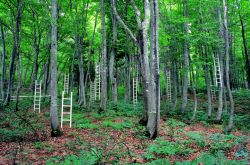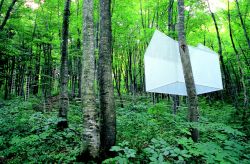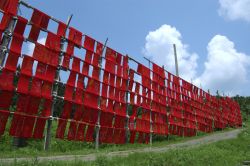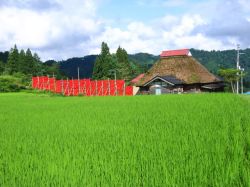Echigo-Tsumari and Australia
In winter, the mountainous Echigo-Tsumari region experiences some of the heaviest snowfalls in Japan. In summer the area is rich and green. In contrast, Australia is a vast, dry continent in the southern hemisphere. Over two-thirds of Australia's land surface is covered by vast desert where red clay earth stretches out into the horizon. It may seem as though Echigo-Tsumari and Australia don't have much in common. However, the Art Triennale stage and Australia have a profound connection.
The theme of the Art Triennale is "human beings are a part of nature" - a concept that Australians can relate to. Australia is an ancient continent which has been inhabited by its indigenous people for more than 40,000 years. They learned to coexist with a harsh natural environment by passing on their customs and traditions from generation to generation. This sense of tradition can be seen in Fiona Foley's "Dharma Eye" presented in the First Triennale and also in the "Spirit Country: Contemporary Australian Aboriginal Art" exhibition from the Second Triennale.
Another important concept in the Echigo-Tsumari Art Triennale is "Communications and Collaborations". This concept is exhibited by the coexistence of the artists and the group of Triennale volunteers called "Kohebi-Tai (Small Snakes)", with the local community. Australia is a multi-cultural country with people from a rich variety of backgrounds who have overcome their differences. Dadang Christanto, an artist born in Indonesia, who is also an Australian resident, participated in the third Triennale and Alex Rizkalla, a Melbourne resident who was born in Egypt, took part in the fourth Triennale.
Australia's love for "Nature and Art" has brought about this deep relationship with the Echigo-Tsumari area, which started back with the first Art Triennale held in 2000. Works made by Australian artists in 2003 are now permanently exhibited in a private house in the Uwayu community. In the fourth Art Triennale in 2009, three artists and a curator stayed in an abandoned house in the Urada community before and during the Triennale. At the House, they created their installations and communicated with the local residents and also with people from around the world. In 2010, the House provided opportunities for cultural exchange between Australia and Japan through the Artist in Residence Program and Japan Australia Art Musings by art students from both countries. To our great regret, Australia House was severely damaged in an aftershock in the days that followed the catastrophic earthquake that hit Japan on 11 March. Even though the initial Australia House has now been lost, we believe it is important that the program proceeds in order to further strengthen the ties between Australia and Japan.
The Participation of Australia in the Art Triennale
The First Art Triennale (2000)
- Fiona Foley "Dharma Eye"
- Anne Graham
-
Hossein Valamanesh "In Memory of Snow"

The Second Art Triennale (2003)
- Anne Graham "Snake Path"
- Nigel Helyer "Everything is Nice with American Rice"
- Janet Laurence "Elixir" Permanent Installation
- Lauren Berkowitz "Harvest House" Permanent Installation
- Robyn Backen "Rice Talk" Permanent Installation
- "Spirit Country: Contemporary Australian Aboriginal Art" Exhibited at Echigo-Matsunoyama Museum of Natural Science
- Sally Couacaud, an independent art curator participated as a Short Video Festival Jury.
- Dawn Casey, director of the National Museum of Australia (at that time) participated as a panellist in the Global Environmental Seminar
- Anthony Bond, Assistant Director, Art Gallery of New South Wales participated in the Echigo-Tsumari Art Symposium
The Third Art Triennale (2006)
More about the Australian artists in 2006
- Anne Graham "Fishing House"
- Dadang Christanto "Cakra Kul-Kul at Tsumari"
- Sue Pedley "HAZE"
- Ben Morieson "Burnout 2006-Radio Controlled in Echigo-Tsumari"
- Andrea Kleist, Public Art Program Manager for the City of Melbourne participated as coordinator
The Fourth Art Triennale (2009)
More about the Australian artists in 2009
- Lucy Bleach "Oral Fibre"
- Alex Rizkalla "Japan Kunstkammer"
- Richard Thomas "OIKOS"
- Cass Matthews participated as coordinator
- Anthony Bond, Assistant Director, Art Gallery of New South Wales contributed as Art Advisor of the Triennale
- Australia House Started
2009 Australia House News Archives
2009 Australia House Photo Archives
2010 (Participated in the Echigo-Tsumari Art Field)
More about the Australian artists in 2010
-
Australia House
- Artist-in-Residency Program
- Japan Australia Art Musings Project
2010 Australia House News Archives
2010 Australia House Photo Archives
Comments from Australia on the Art Triennale
Anthony Bond
Assistant Director, Curatorial & Head Curator International Art
Art Gallery of New South Wales
"I have been at all four Triennales since 2000 and each time it has been a delightful experience. I have been invited into private houses in small communities where we have had wonderful personal contact, spending weeks living in the community. I have found country people easy to communicate with in spite of language barriers. Everyone is enthusiastic and helpful. It is this interaction with major international art identities with local people that makes this such a unique event and by far the most enjoyable International contemporary art festival. The landscape and the traditional villages in the region also make this an amazing opportunity for international artists and most of all when they are able to work with the architecture. The permanent installations are also astonishing from Janet Laurence and Marina Abramovic and Robyn Backen in the old village in the hills to Anne Graham's Snake path in Nanatsugama and to Boltanski and Turrell and many others this is as good an art experience as you can find anywhere in the world."
Hossein Valamanesh
Artist

"My involvement in the first Echigo-Tsumari Art Triennale was part of an ongoing relationship with Art Front Gallery and Mr Fram Kitagawa. It was a great opportunity to explore a number of ideas and sites and eventually construct the temporary installation "In Memory of Snow".
The cooperative process of working with volunteers and staff of the Triennale was very rewarding. Over the last Triennales I've been aware of further involvement with Australian artists and the establishment of Australia House is another step in this cultural exchange and I hope that I'll continue to be involved in the future."
Andrea Kleist
Public Art Program Manager, City of Melbourne
Having had the opportunity to deeply engage with the 2006 Triennale, this event and its people created a memorable experience that still resonates within me. The Echigo-Tsumari Triennale constitutes a most generous invitation: it is an opportunity to encounter a compelling selection of artworks located throughout the arresting landscape of northern Japan; to connect with the local culture and its people and by doing so to comprehend their specific concerns whilst pondering universal questions. This far-reaching hybrid art project emphasizes the human scale - genuine human needs and human dreams. It is compassionately local and thoughtfully international, truly relevant in its intention and tremendously sincere in its ambition.
Spread out across the Niigata region this Triennale resists quick consumption but rather fosters an approach akin to a pilgrimage, inherently devoted to life and its complexities. The ever-growing success of this initiative is a testament to the commitment of organisers, volunteers and participating artists and to the openness of the local Japanese communities.
Sue Pedley
Artist
My first visit to Echigo-Tsumari was during the autumn of 2004 to research a project for the Echigo-Tsumari Art Triennale 2006 at a time when the farmers were busy harvesting the rice. My project involved local people of all ages with the assistance of Kohebi-tai (volunteers from the city), embroidering 500 woollen tapestries based on traditional woven objects Two years later I returned to install my work in the summer. It was a very exciting experience winding through the lush green landscape of Matsunoyama to the Shinto Rice Festival in the small village of Matsuguchi.
Working on high ladders we attached the tapestries onto a 'haze', a large wooden structure used for drying rice. In the midst of heavy rain we huddled in a farm shed drinking tea, singing and laughing. During the process of art -making warm and open relationships had formed between the farmers and the Kohebi-tai, so much so they planned to return to help with the harvest.


At the time of the triennale we travelled through the mountains seeing extraordinary art projects involving communities. In all the villages old and often abandoned wooden houses were being restored by artists and architects or used as installation space. In one house a group of architecture students carved patterns all over the old wooden beams and floors revealing layers of smoke stained surfaces.
One of the most memorable walks for me was through a beech forest, following stone markers inscribed with provocative words by Jenny Holzer. An unforgettable experience was a night spent in Marina Abramovic's 'Dream House' taking a bath filled with local herbs and then sleeping in a box with a stone pillow.
It was enriching meeting local people and artists and volunteers from so many places during this exciting event, which has left a lasting impression on me.

